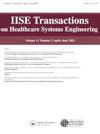智能和互联健康系统的网络建模和物联网——智能心脏健康监测和管理的案例研究
IF 1.5
Q3 HEALTH CARE SCIENCES & SERVICES
IISE Transactions on Healthcare Systems Engineering
Pub Date : 2020-04-06
DOI:10.1080/24725579.2020.1741738
引用次数: 16
摘要
在美国,心脏病是导致死亡的主要原因。物联网(IoT)的最新进展提供了一个很好的机会,通过物联网监测和基于传感器的心脏疾病数据分析来实现智能和连接的健康系统。然而,大规模物联网系统产生的大数据对高效、有效的感官信息处理和决策提出了重大挑战。在大规模物联网网络的背景下,收集有关疾病改变的心脏活动的相关信息的工作很少。在这项研究中,我们提出了一个并行计算框架,用于多级网络建模和心脏动力学监测,以实现物联网智能健康管理的潜力。具体来说,首先在单个患者的心跳之间以及不同患者的代表性心跳之间表征心脏信号的差异性。然后,开发了一种随机学习方法来优化心脏信号嵌入到心跳对心跳网络模型以及患者对患者网络模型中。进一步,我们开发了一种并行计算算法来提高计算效率。最后,设计了一种统计过程监测方案,利用网络特性对心脏活动进行实时监测和异常检测。实验结果表明,该方法具有实现大规模物联网环境下智能互联心脏健康管理系统的强大潜力。本文章由计算机程序翻译,如有差异,请以英文原文为准。
Network modeling and Internet of things for smart and connected health systems—a case study for smart heart health monitoring and management
Abstract Heart disease is a leading cause of death in the US. Recent advances in the Internet of Things (IoT) provide a great opportunity to realize smart and connected health systems through IoT monitoring and sensor-based data analytics of cardiac disorders. However, big data arising from the large-scale IoT system pose a significant challenge for efficient and effective sensory information processing and decision making. Very little has been done to glean pertinent information about the disease-altered cardiac activity in the context of large-scale IoT network. In this study, we propose a parallel computing framework for multi-level network modeling and monitoring of cardiac dynamics to realize the potential of IoT-enabled smart health management. Specifically, dissimilarities among cardiac signals are firstly characterized among heartbeats for an individual patient, as well as among representative heartbeats for different patients. Then, a stochastic learning approach is developed to optimize the embedding of cardiac signals into a beat-to-beat network model, as well as a patient-to-patient network model. Further, we develop a parallel computing algorithm to improve the computational efficiency. Finally, a statistical process monitoring scheme is designed to harness network features for real-time monitoring and anomaly detection of cardiac activities. Experimental results show the proposed methodology has strong potential to realize a smart and interconnected system for cardiac health management in the context of large-scale IoT network.
求助全文
通过发布文献求助,成功后即可免费获取论文全文。
去求助
来源期刊

IISE Transactions on Healthcare Systems Engineering
Social Sciences-Safety Research
CiteScore
3.10
自引率
0.00%
发文量
19
期刊介绍:
IISE Transactions on Healthcare Systems Engineering aims to foster the healthcare systems community by publishing high quality papers that have a strong methodological focus and direct applicability to healthcare systems. Published quarterly, the journal supports research that explores: · Healthcare Operations Management · Medical Decision Making · Socio-Technical Systems Analysis related to healthcare · Quality Engineering · Healthcare Informatics · Healthcare Policy We are looking forward to accepting submissions that document the development and use of industrial and systems engineering tools and techniques including: · Healthcare operations research · Healthcare statistics · Healthcare information systems · Healthcare work measurement · Human factors/ergonomics applied to healthcare systems Research that explores the integration of these tools and techniques with those from other engineering and medical disciplines are also featured. We encourage the submission of clinical notes, or practice notes, to show the impact of contributions that will be published. We also encourage authors to collect an impact statement from their clinical partners to show the impact of research in the clinical practices.
 求助内容:
求助内容: 应助结果提醒方式:
应助结果提醒方式:


